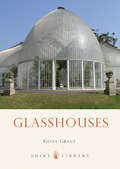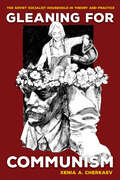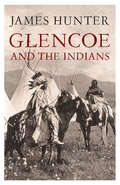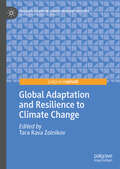- Table View
- List View
Glasshouses (Shire Library #747)
by Fiona GrantSince the early seventeenth century, when the cultivation of exotic plants and fruit became fashionable in northern Europe, glasshouses have offered an artificial climate in which they could flourish. At first these structures were within reach only of the very richest, and growing one's own oranges, orchids, pineapples or bananas was a sign of great wealth; but by the mid-nineteenth century manufacturers emerged to cater for a growing middle-class market. Glasshouses became increasingly sophisticated, with different types tailored to house specific crops, and manufacturers competing with one another by developing their own house styles, leading to a wealth of designs endlessly fascinating to the garden or architectural historian. In Glasshouses, Fiona Grant provides an illustrated introduction to the subject, including the twentieth century decline and recent attempts at restoration.
Glasshouses (Shire Library #747)
by Fiona GrantSince the early seventeenth century, when the cultivation of exotic plants and fruit became fashionable in northern Europe, glasshouses have offered an artificial climate in which they could flourish. At first these structures were within reach only of the very richest, and growing one's own oranges, orchids, pineapples or bananas was a sign of great wealth; but by the mid-nineteenth century manufacturers emerged to cater for a growing middle-class market. Glasshouses became increasingly sophisticated, with different types tailored to house specific crops, and manufacturers competing with one another by developing their own house styles, leading to a wealth of designs endlessly fascinating to the garden or architectural historian. In Glasshouses, Fiona Grant provides an illustrated introduction to the subject, including the twentieth century decline and recent attempts at restoration.
Gläubiger, Schuldner, Arme: Netzwerke und die Rolle des Vertrauens
by Curt Wolfgang HergenröderArmut und finanzielle Überforderung privater Haushalte sind zu einem gesellschaftspolitischen Problem ersten Ranges geworden. Allein in Deutschland gelten rund 10 % der über 18-Jährigen als überschuldet. Für die nächsten Jahre wird angesichts der wirtschaftlichen und sozialen Entwicklung ein weiterer Anstieg armutsbedingter Problemlagen und von Privatinsolvenzen prognostiziert. Maßnahmen zur Unterstützung von armen und zahlungsunfähigen Personen sowie Präventionsstrategien zur Vermeidung von Armut und Überschuldung werden dringend notwendig. Der Forscherverbund „Gesellschaftliche Abhängigkeiten und soziale Netzwerke“ der Universitäten Mainz und Trier hat es sich, gefördert durch die Exzellenzinitiative des Landes Rheinland-Pfalz, zur Aufgabe gemacht, die verschiedenen Facetten der Schuldenproblematik in transdisziplinärer Zusammenarbeit zu hinterfragen. Ziel der Forschergruppe, deren Mitglieder aus der Erziehungswissenschaft, der Geschichte, der Kriminologie, den Rechtswissenschaften, der Sozialmedizin sowie der Wirtschaftspädagogik kommen, ist die nähere Erforschung der Ursachenzusammenhänge zwischen der Entstehung von Armut und Schulden, den Auswirkungen dieser Problemlagen auf die wirtschaftliche, rechtliche, soziale und gesundheitliche Lebenssituation sowie dem Bewältigungshandeln der daraus resultierenden Probleme.
Glaubwürdigkeit in der sozialen Kommunikation (Studien zur Kommunikationswissenschaft)
by Ute NawratilWas macht Menschen glaubwürdig? Die Frage stellt sich insbesondere für Personen, die wir nicht von Angesicht zu Angesicht sondern nur durch die Medien "kennen". Das Buch zeigt auf, welche Kriterien für eine Einschätzung der Glaubwürdigkeit herangezogen werden und erläutert am Beispiel politischer Skandale, auf welche Weise die Darstellung in den Medien dazu beiträgt, die Glaubwürdigkeit von Politikern zu stützen oder zu untergraben.
Gleaning for Communism: The Soviet Socialist Household in Theory and Practice
by Xenia A. CherkaevGleaning for Communism is a historical ethnography of the property regime upon which Soviet legal scholars legislated a large modern state as a household, with guaranteed rights to a commons of socialist property, rather than private possessions. Starting with former Leningrad workers' everyday stories about smuggling industrial scrap home over factory fences, Xenia Cherkaev traces collectivist ethical logic that was central to this socialist household economy, in theory and practice: from its Stalin-era inception, through Khrushchev's major foregrounding of communist ethics, to Gorbachev's perestroika, which unfurled its grounding tension between the interests of any given collective and of the socialist household economy itself. A story of how the socialist household economy functioned, how it collapsed, and how it was remembered, this book is haunted throughout by a spectral image of the totalitarian state, whose jealous political control over the economy leads it to trample over all that which ought to be private. Underlying this image, and the neoliberal state phobia it justified, is the question of how individual interests ought to relate to the public good in a large modern society, which, it is assumed, cannot possibly function by the non-private logics of householding. This book tells the story of a large modern society that did.
Gleiche Chancen im Sozialstaat?
by Carl Böhret Garry D. Brewer Ronald D. Brunner Herbert Ehrenberg Klaus Liepelt Erika Spiegel Günter StruveWas will TRANSFER? Die Reihe TRANSFER will die Aufmerksamkeit auf sozialwissenschaftliehe Da ten und Konzepte lenken, die den Politikern und Planem bei der Bestimmung von Reformzielen und deren Begründung helfen können. Dabei soll es vor allem auch darum gehen, die umfangreichen Erfahrungen zu verwerten, die bislang in der Auftragsforschung für die öffentliche Hand gesammelt werden konnten. Es kommt bei diesem Vorhaben nicht nur auf die Aufmerksamkeit einer engen Fachöffentlichkeit an, sondern vor allem auf den Dialog mit denen, die es angeht: auf den Transfer der Argumente und Daten zwischen Politik und Wissen schaft - und zwar in beiden Richtungen. Das erfordert eine Verständlichkeit und Überschaubarkeit der dargebotenen Information, die sie auch für Unterricht und Lehre nützlich erscheinen lassen. TRANSFER bietet schwerpunktartige Information. Zu jeweils einem Thema werden Daten, politische und wissenschaftliche Konzepte gebündelt. Ein voll ständiger Überblick über den Stand der Forschung ist nicht beabsichtigt, wohl aber werden beispielhaft Beiträge vorgeführt, die für wichtige Vorstöße der For schung stehen.
Gleichgeschlechtlich liebende Frauen im Alter: Intersektionalität, Lebenslagen und Antidiskriminierungsempfehlungen
by Bärbel S. TraunsteinerBärbel S. Traunsteiner erforscht die aktuellen Lebenslagen gleichgeschlechtlicher Frauen über 60 Jahre. Entlang der intersektionalen Schnittstellen von Alter, Geschlecht und sexueller Orientierung analysiert die Autorin die spezifische sozial-strukturelle Positionierung dieser bisher sowohl (sozial‑)politisch als auch wissenschaftlich wenig beachteten Zielgruppe am Beispiel von Österreich. Vielschichtige Einblicke hinsichtlich der ökonomischen und beruflichen Situation, der sozialen Kontakte sowie in Bezug auf private und öffentliche Räume älterer Lesben werden dargelegt. Rund 55 grundlegende Empfehlungen zur (Weiter-)Entwicklung und Verbesserung von (Antidiskriminierungs-)Maßnahmen betreffend gleichgeschlechtlich l(i)ebender älterer Frauen auf gesellschafts- wie sozialpolitischer, gesetzlicher ebenso wie auf organisationaler Ebene runden die Recherche ab.
Gleichheit, Politik und Polizei: Jacques Rancière und die Sozialwissenschaften (Kulturelle Figurationen: Artefakte, Praktiken, Fiktionen)
by Thomas Linpinsel Il-Tschung LimJacques Rancière gilt als einer der einflussreichsten französischen Philosophen der Gegenwart, in dessen gesamtem Werk immer wieder das Motiv der radikalen Kritik an der Sozialwissenschaft in Szene gesetzt wird. In dem Sammelband werden zahlreiche Denkmotive des französischen Philosophen aus einer genuin sozialwissenschaftlichen Perspektive aufgegriffen, weitergedacht und kritisiert, wobei in den einzelnen Artikeln konkrete Forschungsperspektiven mit Rancière entwickelt, methodologische Überlegungen im Anschluss an Rancière vorgestellt, gesellschaftstheoretische Reflexionen vor dem Hintergrund der Kritik des Philosophen unternommen sowie Aspekte seines politischen Denkens in die politische Theorie integriert werden. Aber auch sozialwissenschaftliche Kritik an der Philosophie Rancières findet in den Argumentationen der Autorinnen und Autoren ihren Platz. Somit bietet der Band ein breit gefächertes Spektrum an sozialwissenschaftlichen Anschlüssen an das Denken des französischen Philosophen. Einerseits schließt der Sammelband damit eine Lücke in der sozialwissenschaftlichen Forschung und ist anderseits der erste genuin sozialwissenschaftliche Beitrag in der umfangreichen jüngeren Forschung zum philosophischen Werk Rancières.
Gleichstellung als Profession?: Gleichstellungsarbeit an Hochschulen aus professionssoziologischer Sicht (Geschlecht und Gesellschaft #70)
by Lina VollmerDie Gleichstellungsarbeit an Hochschulen in Deutschland weist vor dem Hintergrund hochschulischer Reformprozesse Merkmale eines Professionalisierungsprozesses auf. Anhand eines Mixed Methods Ansatzes wird in dem vorliegenden Buch die Ausprägung der soziologischen Professionskriterien untersucht. Während die quantitative Untersuchung einen positiven Zusammenhang zwischen wissenschaftlichem Geschlechterwissen und dem Professionalisierungsgrad nachweist, zeigt die qualitative Interviewstudie die Heterogenität unterschiedlicher Akteurinnentypen und deren Bezug zu diesem Wissen. Für den (weiteren) Professionalisierungsprozess sind das wissenschaftliche Geschlechterwissen und der Transfer dieses Wissens in die Gleichstellungspraxis fundamental.
Gleichstellung im Feuerwehrwesen: „Gut Wehr!“ und die HeldInnen von heute
by Ilona HorwathIn den letzten Jahrzehnten sind Frauen sukzessive in vormals rein männerdominierte Berufsbereiche eingetreten. Eine solche Männerdomäne stellt auch das Feuerwehrwesen dar: Während Freiwillige Feuerwehren zum Teil regen Zulauf von Frauen und Mädchen verzeichnen, sind höhere Funktionen und berufliche Positionen im Feuerwehrwesen noch weitgehend männlich besetzt. Ilona Horwath untersucht die Gründe dafür und analysiert die Entwicklung von Gleichstellungsprozessen auf internationaler, nationaler und regionaler Ebene. Die Autorin präsentiert Ergebnisse einer regionalen Fallstudie, die mit qualitativen und quantitativen Methoden nachzeichnet, wie es zur Vergeschlechtlichung dieser Organisationen kommt. Im Zentrum stehen dabei die Erfahrungen und Einschätzungen der ehrenamtlichen wie professionellen Feuerwehrleute. Welche Geschlechterorientierungen dominieren im Feuerwehrwesen und inwiefern fördern oder behindern diese eine gleichstellungsorientierte Integration von Frauen und Mädchen?
Gleichstellung messbar machen: Grundlagen und Anwendungen von Gender- und Gleichstellungsindikatoren
by Angela Wroblewski Udo Kelle Florian ReithDieser Band schließt eine wichtige Lücke in den politischen und wissenschaftlichen Debatten um Gleichstellung, indem die zahlreichen Herausforderungen, die die Entwicklung und Bewertung von Indikatoren für Gleichstellung mit sich bringen, umfassend dargestellt und diskutiert werden. Auf dieser Basis werden allgemeine Kriterien für die Entwicklung von Gender- und Gleichstellungsindikatoren formuliert. Neben den methodischen und gendertheoretischen Fragen, die hierbei berücksichtigt werden müssen, wird auch auf die Rolle von Gender- und Gleichstellungsindikatoren im Rahmen politischer Prozesse eingegangen.
Gleichstellungsorientierte Arbeit mit Mädchen und jungen Frauen: Eine bundesweite Bestandsanalyse
by Dipl. Päd. Daigler Elisabeth Yupanqui-Werner Sylvia Beck Bea DörrDas Buch präsentiert die Untersuchungsergebnisse einer zweijährigen Studie, die den Anspruch hatte, über den Tellerrand der Jugendhilfe hinaus zu blicken und nach Themen, Strukturen, AkteurInnen sowie nach Möglichkeiten und Konflikten einer kommunalen gleichstellungsorientierten Arbeit für Mädchen und jungen Frauen zu fragen. Die Studie bietet einen breiten Überblick über die Praxis einer gleichstellungsorientierten Arbeit mit Mädchen und jungen Frauen. In den unterschiedlichen Erhebungsschritten werden die Perspektiven Ost/West sowie Stadt/Land jeweils berücksichtigt. Gezeigt werden kann dabei auch, welche zentrale Bedeutung die kommunalen Frauen-/Gleichstellungsbeauftragten an der Schnittstelle von Gleichstellungspolitik und Mädchenförderung haben, da sie qua ihres Querschnittsamtes Kontakte zu unterschiedlichen Akteurinnen und Akteuren (in Schulen, Vereinen, Kindertagesstätten, Kultureinsrichtungen, Unternehmen, Gemeinderäten, Fraueninitiativen etc.) aufbauen und pflegen können. Gerade aus deren Arbeit und Erfahrungen heraus lassen sich Anforderungen an ein gelingendes kommunales Gender Mainstreaming formulieren
Gleichstellungspolitik im Kontext neuer Governance an Universitäten (Geschlecht und Gesellschaft #77)
by Birgit ErbeDas Buch widmet sich den immensen Herausforderungen, die an die Gleichstellungspolitik an Hochschulen gestellt werden, und stützt sich dabei auf Ansätze der Governance-, Organisations- und Geschlechterforschung. Mit der Hochschulreform seit Ende der 1990er Jahre sollte das ‚Steuerungsproblem‘ des Hochschulbereichs mit neuen, vom New Public Management geprägten Formen der Governance gelöst werden. Da das Steuerungsproblem auch auf die Hochschulgleichstellungspolitik zutrifft, sind die beiden zentralen Fragen der Untersuchung: Wo liegen die Chancen und Grenzen der veränderten Governance-Strukturen für Gleichstellungspolitik? Was bedeuten sie für die Praxis der Gleichstellungsakteur_innen an den Universitäten und für die Politik? Anhand von vier kontrastierenden Organisationsfallstudien wird nachvollzogen, wie es den untersuchten Universitäten trotz schwieriger Rahmenbedingungen gelingt, längerfristige gleichstellungspolitische Veränderungen innerhalb ihrer Organisationen zu realisieren und welche Faktoren dafür ausschlaggebend sind.
Gleichstellungspolitiken revisted: Zeitgemäße Gleichstellungspolitik an der Schnittstelle zwischen Politik, Theorie und Praxis
by Angela Wroblewski Angelika SchmidtAnfang der 1990er Jahre wurde erstmals von einem Backlash im Bereich der Frauenförderung und Gleichstellung gesprochen und die Strategien des Patriachats aufgezeigt, die den Forderungen von Frauen* nach gleichberechtigter Teilhabe entgegengesetzt werden. Aktuell wird wieder – nicht nur in Österreich – von einem Backlash gesprochen, der sich beispielsweise in einer Abkehr von der geschlechtsneutralen Sprache, in der Kürzung von Subventionen für Frauen- und Mädchenberatungseinrichtungen, im Rückbau von Institutionen und in Angriffen auf die Gender Studies niederschlägt. Zu diesen Phänomenen von Backlash kam es trotz der Etablierung zahlreicher Institutionen im Bereich Gleichstellung und Bekenntnisse zur Förderung von Vielfalt auf politischer Ebene und von Unternehmensseite. Ausgehend von diesem ambivalenten Befund zum Status Quo von Gleichstellung werden Anforderungen an eine zeitgemäße Gleichstellungspolitik an der Schnittstelle zwischen Politik, Theorie und Praxis formuliert. Die Beiträge in dem Band zeigen aktuelle Herausforderungen für Gleichstellungspolitik und illustrieren, wie die Schnittstelle ausgestaltet werden kann.
Gleichstellungsregime: Berufliche Gleichstellung von Frauen in den USA und in der Bundesrepublik Deutschland (Politik und Geschlecht #2)
by Angelika Wahl,Gleichstellung' wird als Geschlechterfrage begriffen, die Aussagen macht zur gegenwärtigen Machtverteilung auf dem Arbeitsmarkt, zu geschlechtsspezifischen Zugangsmöglichkeiten bzw. Hindernissen und zu den Chancen und Defiziten verschiedener Gleichstellungsansätze. Sechs Gleichstellungsansätze und ihr politischer und gesellschaftlicher Entstehungszusammenhang werden dargestellt. Die theoretische Frage ist, wieso ein traditionell ,schwacher' Staat, wie die USA, eine, stärkere' Gleichstellungspolitik entwickelt hat, als die Bundesrepublik Deutschland, die sonst eine lange Geschichte staatlicher Eingriffe in den Arbeitsmarkt aufweist. Welche Bedeutung haben das politische Regime, die Ausrichtung des Arbeitsmarktes sowie die Ideologie und Mobilisierung sozialer Bewegungen, insbesondere der Frauenbewegung, auf die Formulierung, inhaltliche Ausrichtung und Institutionalisierung von Gleichstellungspolicies gehabt? Neben der Politik auf nationaler Ebene wird in zwei Fallstudien die Wechselbeziehung zwischen staatlichen Instanzen und Frauenorganisationen im Hinblick auf die Umsetzung von Gleichstellung untersucht.
Glencoe and the Indians
by James HunterIn 1876, they wipe out General George A. Custer and his 7th Cavalry at the Battle of the Little Bighorn. Chief Sitting Bull and his Sioux people then flee from the United States to Canada. There, in the autumn of 1877, the Sioux are joined by the remnants of the latest Indian nation to make a stand against the US Army, the Nez Perce. Their survivors are led by Chief White Bird.A young man follows White Bird to Sitting Bull's camp. He is White Bird's close relative and aims to tell the story of the Nez Perce War from the Nez Perce point of view. This young man's name is Duncan McDonald. Descended from chiefs of the Nez Perce and from chiefs of Scotland's most formidable clan, Duncan's family - first as Highlanders, then as Native Americans - have twice been victims of massacre and dispossession.Written with the help of Duncan McDonald's present-day kinsfolk on the Flathead Indian Reservation in Western Montana, this real-life family saga spans two continents and more than thirty generations to link Scotland's clans with the native peoples of the American West.
Glimpses of Hope: The Rise of Industrial Labor at the Urban Margins of Nepal (Dislocations #32)
by Michael HoffmannOver the last decade, Nepal has witnessed significant urban growth and an expanding urban middle class. Glimpses of Hope tells the story of the people who enable some of the middle-class consumer practices in urban Nepal. The book focuses on workers in areas such as modern food-processing, water-bottling, housebuilding, and sand-mining industries and explores how workers see such forms of work, where union organization can help, and how work opportunities emerge along lines of gender and ethnicity. Although global labor relations have been mostly in decline for decades, this ethnography offers insights and glimpses of hope in terms of labor dynamics and the opportunities various jobs may afford.
Glimpses of Hope: The Rise of Industrial Labor at the Urban Margins of Nepal (Dislocations #32)
by Michael HoffmannOver the last decade, Nepal has witnessed significant urban growth and an expanding urban middle class. Glimpses of Hope tells the story of the people who enable some of the middle-class consumer practices in urban Nepal. The book focuses on workers in areas such as modern food-processing, water-bottling, housebuilding, and sand-mining industries and explores how workers see such forms of work, where union organization can help, and how work opportunities emerge along lines of gender and ethnicity. Although global labor relations have been mostly in decline for decades, this ethnography offers insights and glimpses of hope in terms of labor dynamics and the opportunities various jobs may afford.
Glitter (Object Lessons)
by Nicole SeymourObject Lessons is a series of short, beautifully designed books about the hidden lives of ordinary things.Glitter reveals the complexity of an object often dismissed as frivolous. Nicole Seymour describes how glitter's consumption and status have shifted across centuries-from ancient cosmetic to queer activist tool, environmental pollutant to biodegradable accessory-along with its composition, which has variously included insects, glass, rocks, salt, sugar, plastic, and cellulose. Through a variety of examples, from glitterbombing to glitter beer, Seymour shows how this substance reflects the entanglements of consumerism, emotion, environmentalism, and gender/sexual identity. Object Lessons is published in partnership with an essay series in The Atlantic.
Glitter (Object Lessons)
by Nicole SeymourObject Lessons is a series of short, beautifully designed books about the hidden lives of ordinary things.Glitter reveals the complexity of an object often dismissed as frivolous. Nicole Seymour describes how glitter's consumption and status have shifted across centuries-from ancient cosmetic to queer activist tool, environmental pollutant to biodegradable accessory-along with its composition, which has variously included insects, glass, rocks, salt, sugar, plastic, and cellulose. Through a variety of examples, from glitterbombing to glitter beer, Seymour shows how this substance reflects the entanglements of consumerism, emotion, environmentalism, and gender/sexual identity. Object Lessons is published in partnership with an essay series in The Atlantic.
The Global 1920s: Politics, economics and society (Decades in Global History)
by Richard Carr Bradley W. HartThe 1920s is often recognised as a decade of fascism, flappers and film. Covering the political, economic and social developments of the 1920s throughout the world, The Global 1920s takes an international and cross-cultural perspective on the critical changes and conditions that prevailed from roughly 1919 to 1930. With twelve chapters on themes including international diplomacy and the imperial powers, film and music, art and literature, women and society, democracy, fascism, and science and technology, this book explores both the ‘big’ questions of capitalism, class and communism on the one hand and the everyday experience of citizens around the globe on the other. Utilising archival sources throughout, it concludes with an extensive discussion of the circumstances surrounding the 1929 stock market crash and the onset of the Great Depression, the effects of which were felt worldwide. Covering topics from the oil boom in South America to the start of civil war in China, employment advances and setbacks for women across the globe, and the advent of radio and air travel, the authors provide a concise yet comprehensive overview of this turbulent decade. Containing illustrations and a selection of discussion questions at the end of each chapter, this book is valuable reading for students of the 1920s in global history.
The Global 1920s: Politics, economics and society (Decades in Global History)
by Richard Carr Bradley W. HartThe 1920s is often recognised as a decade of fascism, flappers and film. Covering the political, economic and social developments of the 1920s throughout the world, The Global 1920s takes an international and cross-cultural perspective on the critical changes and conditions that prevailed from roughly 1919 to 1930. With twelve chapters on themes including international diplomacy and the imperial powers, film and music, art and literature, women and society, democracy, fascism, and science and technology, this book explores both the ‘big’ questions of capitalism, class and communism on the one hand and the everyday experience of citizens around the globe on the other. Utilising archival sources throughout, it concludes with an extensive discussion of the circumstances surrounding the 1929 stock market crash and the onset of the Great Depression, the effects of which were felt worldwide. Covering topics from the oil boom in South America to the start of civil war in China, employment advances and setbacks for women across the globe, and the advent of radio and air travel, the authors provide a concise yet comprehensive overview of this turbulent decade. Containing illustrations and a selection of discussion questions at the end of each chapter, this book is valuable reading for students of the 1920s in global history.
Global Activism, Global Media
by Wilma De Jong Martin Shaw Neil StammersRadical political activist movements are growing all the time. Activist politics have come to influence 'mainstream' politics over fundamental issues such as trade, gender relations, the environment and war. *BR**BR*This book brings together activists and academics in one volume, to explore the theory and practice of global activism's relation to all forms of media, mainstream and otherwise. The contributors examine how global activism is represented in the mainstream press and explain the strategies that activists adopt to spread their own ideas.*BR**BR*Investigating Indymedia and internet activism, they show how transformations in communications technology offer new possibilities, and explain how activists have successfully used and developed their own media. Case studies and topics include the world social forums, an example of a campaign from the NGO Action Aid, a campaign strategy from an internet activist, Greenpeace and the Brent Spar conflict, the World Development Movement and representations in the mainstream press, the Independent Media Centre, transgender activism on the net, Amnesty International, Oxfam and the internet.
Global Activism in Food Politics: Power Shift (International Relations and Development Series)
by A. MannWho should provide food, and through what relationships? Whose livelihoods should be protected? For over 20 years the peasant farmers of La Via Campesina have been engaged in the fight against injustice, hunger and poverty under the banner of food sovereignty, 'the right of peoples to healthy and culturally appropriate food produced through ecologically sound and sustainable methods, and their right to define their own food and agriculture systems'. They campaign for healthy, sustainable alternatives to an industrial food system controlled by agribusiness companies and the architects of unfair trade agreements. This book draws on grounded case studies of agrarian movements in the Americas and Europe as exemplars of a 'power shift,' as local opposition scales up to global action in an effort to wrest control of our food away from transnational corporations and back to communities.
Global Adaptation and Resilience to Climate Change (Palgrave Studies in Climate Resilient Societies)
by Tara Rava ZolnikovThis book explores the link between climate change and resiliency on each continent of the world. It reviews how climate change affects populations, not only through environmental exposures and health outcomes, but how people live their lives. Zolnikov brings together a set of experts to offer a novel perspective on understanding climate change vulnerability alongside adaption measures being implemented. Each chapter includes an overview on how climate change will affect that continent alongside current adaptation, mitigation, and policies that seek to improve population outcomes. As a whole, the book explores why a “one size fits all” approach to promote climate change resiliency does not work; however, a global perspective can facilitate people learning from one another and facing climate change together.






















